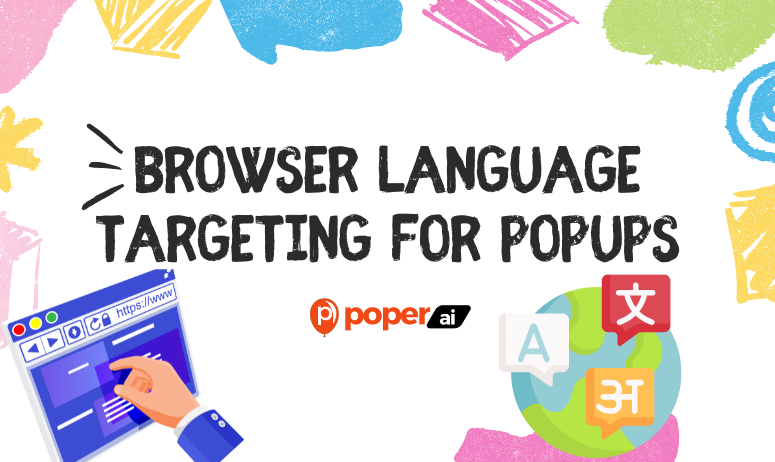The limits of my language mean the limits of my world.
This quote by Ludwig Wittgenstein reflects the profound impact language has on interaction and understanding. In the realm of digital marketing, this impact is magnified through the use of browser language targeting in popups, a strategy that tailors content based on the user's language, thereby fostering a more engaging and personalized browsing experience.
Browser language targeting isn't just a technical functionality—it's a transformative approach to user engagement. By detecting the language settings of a user's browser, businesses can deliver content that resonates on a cultural level, making interactions feel more thoughtful and user-focused. This not only enhances the user experience but also significantly improves the effectiveness of communication and marketing strategies.
The Basics of Browser Language Targeting
Understanding browser language targeting is crucial for implementing it effectively. This technology adapts content based on the language preferences set in a user's browser, providing a personalized experience that can significantly enhance user engagement and satisfaction.
What is Browser Language Targeting?
Browser language targeting is a technique used to detect the language settings of a user’s browser automatically. Websites use this information to display content in the preferred language of the user, making the site more accessible and user-friendly.
How Browsers Identify User Language Settings
Most modern browsers have a default language setting that can be modified by users based on their preferences. This setting is communicated to websites through the HTTP header, which contains information about the user's language preference. Websites can then use this information to serve content in the corresponding language, ensuring that the user's experience is as seamless and personalized as possible.
Benefits of Language-Specific Popups
Language-specific popups are designed to cater directly to the user's linguistic preferences, which can dramatically enhance the effectiveness of digital marketing efforts. Here's how they contribute to better user engagement and higher conversion rates.
Enhancing User Engagement Through Personalized Language Settings
Offering popups in the user's native language can significantly increase their engagement. Users are more likely to interact with content that feels familiar and easy to understand, reducing the likelihood of confusion or misunderstanding that can occur with non-native languages.
Boosting Conversion Rates with Tailored Content
When popups are presented in the user's preferred language, the clarity and relevance of the message increase, leading to higher conversion rates. Whether it's signing up for a newsletter, making a purchase, or participating in a survey, users are more inclined to take action when the call-to-action speaks their language.
Implementing Browser Language Targeting in Poper
Setting up browser language targeting in Poper can transform your popups into powerful tools for reaching a diverse audience. Here’s how you can implement these strategies effectively using Poper’s robust platform.
Implementing Browser Language Targeting in Poper
To effectively reach a diverse audience, Poper allows the creation of tailored popups that automatically adjust to the browser language of your visitors. Here's a step-by-step guide on how to set up browser language targeting using Poper, ensuring your message resonates across different linguistic demographics.
Step 1: Create Your Popup
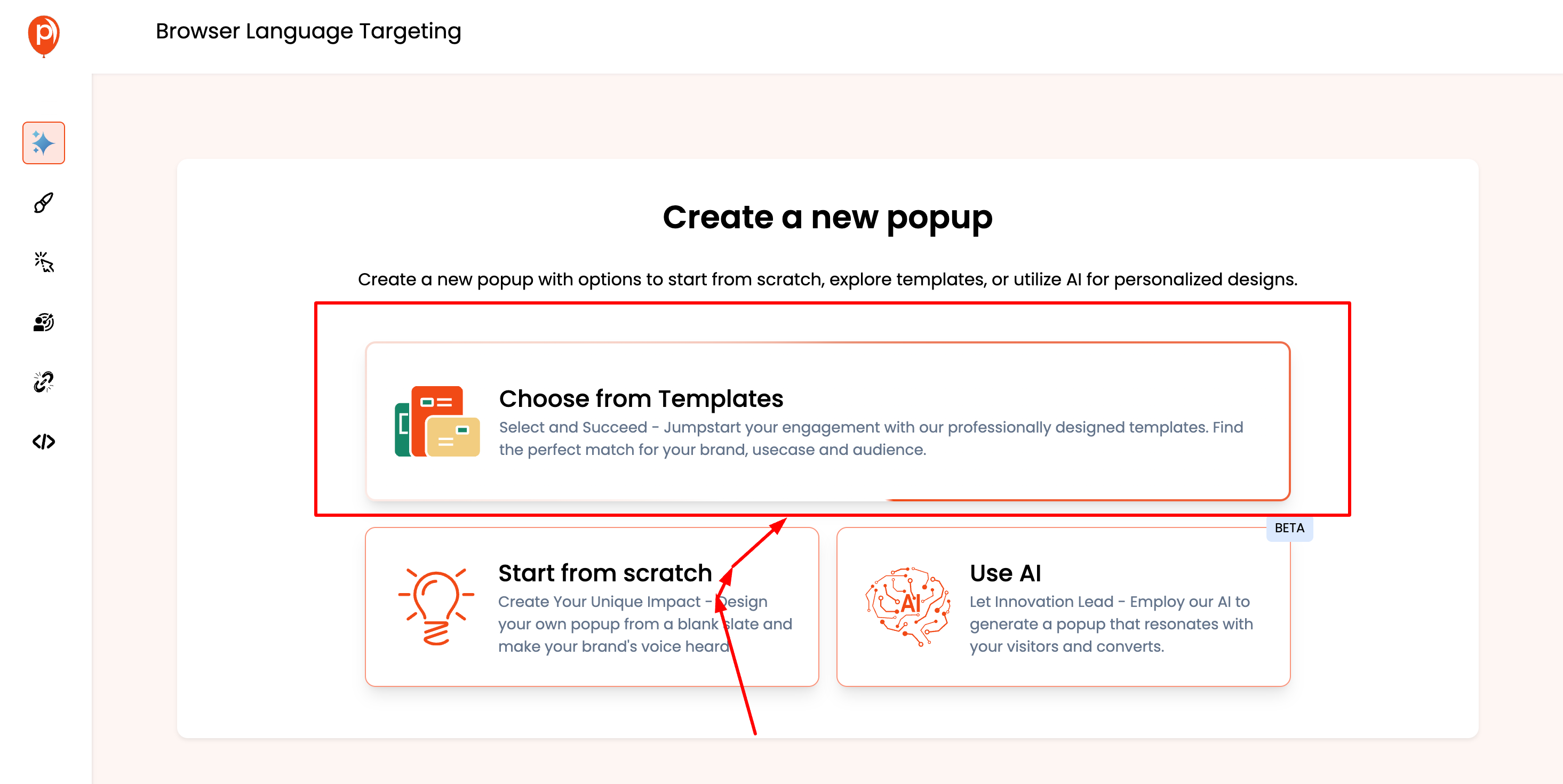
Begin by selecting the option to create a new popup. Poper provides a user-friendly interface where you can either start from scratch or choose from pre-designed templates suited for various purposes and languages.
Step 2: Choose How to Create Your Popup
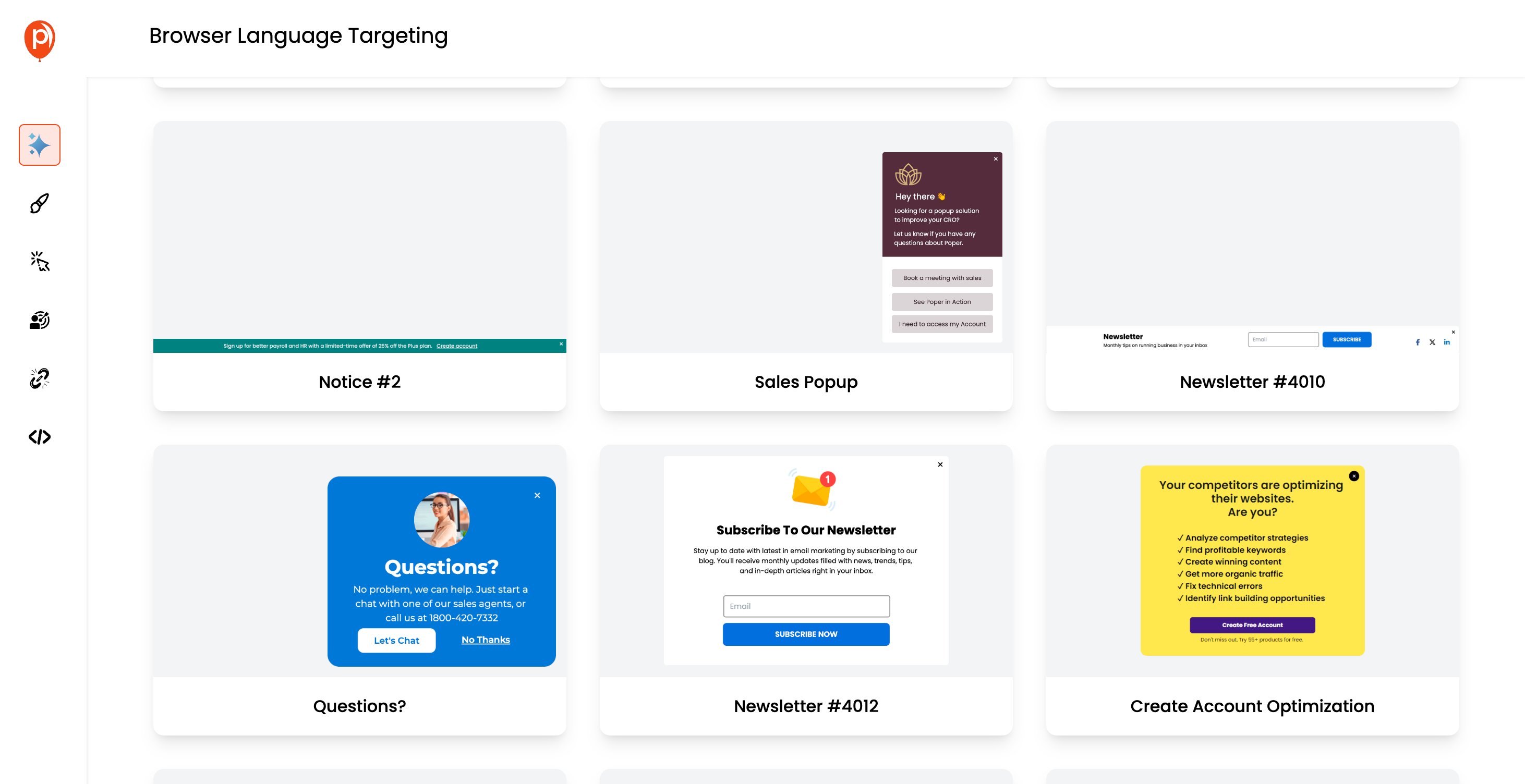
You can opt to use one of Poper's professionally designed templates which are optimized for engagement and conversion, or you might decide to start from scratch to bring a more personalized touch to your design. For browser language targeting, selecting a template that complements a wide range of languages and cultures could be beneficial.
Step 3: Customize Your Template
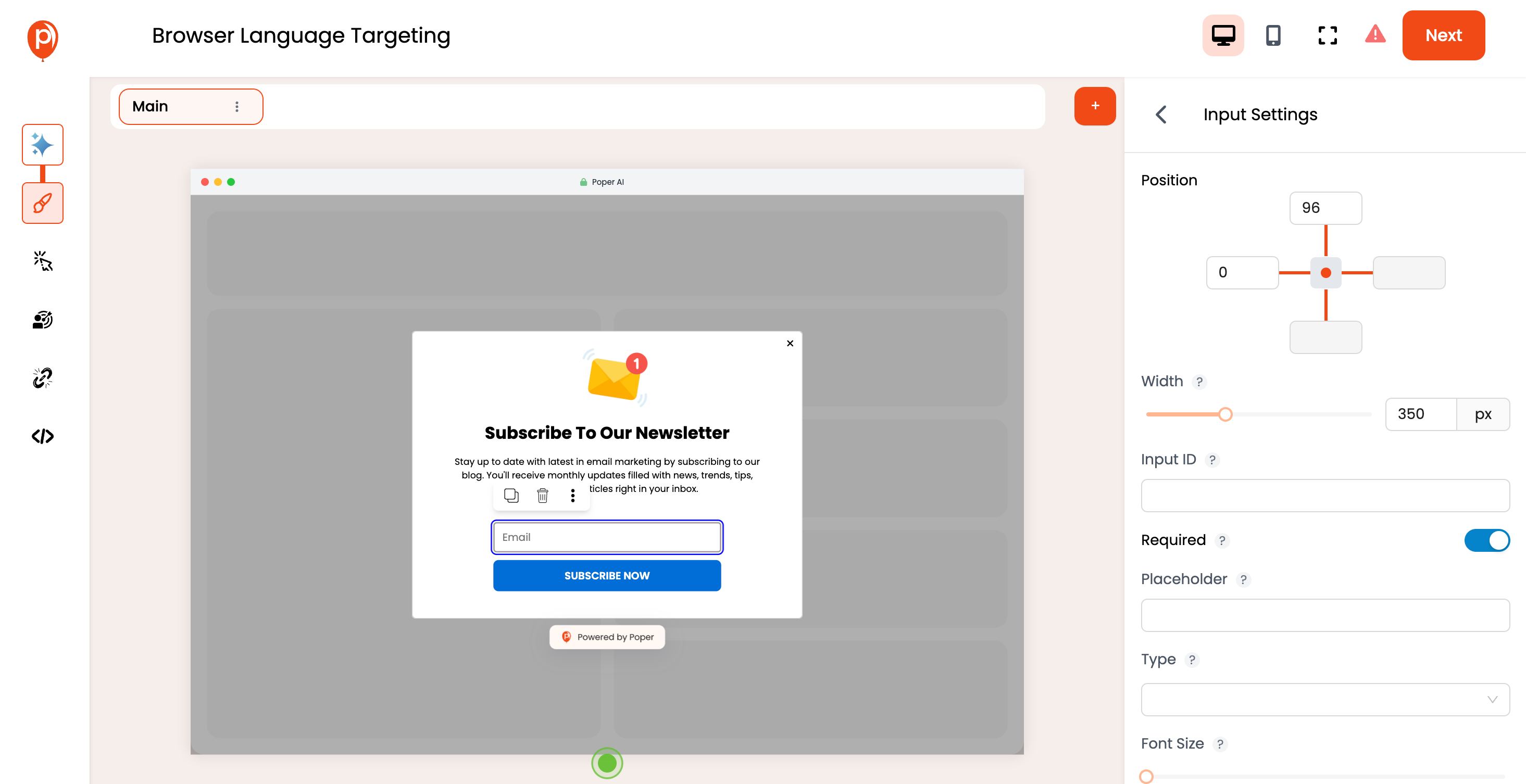
Edit your template to align with your branding and the specific needs of different language speakers. This might involve adjusting the text, colors, and images to better suit cultural nuances and preferences in content presentation.
Step 4: Set Display Triggers
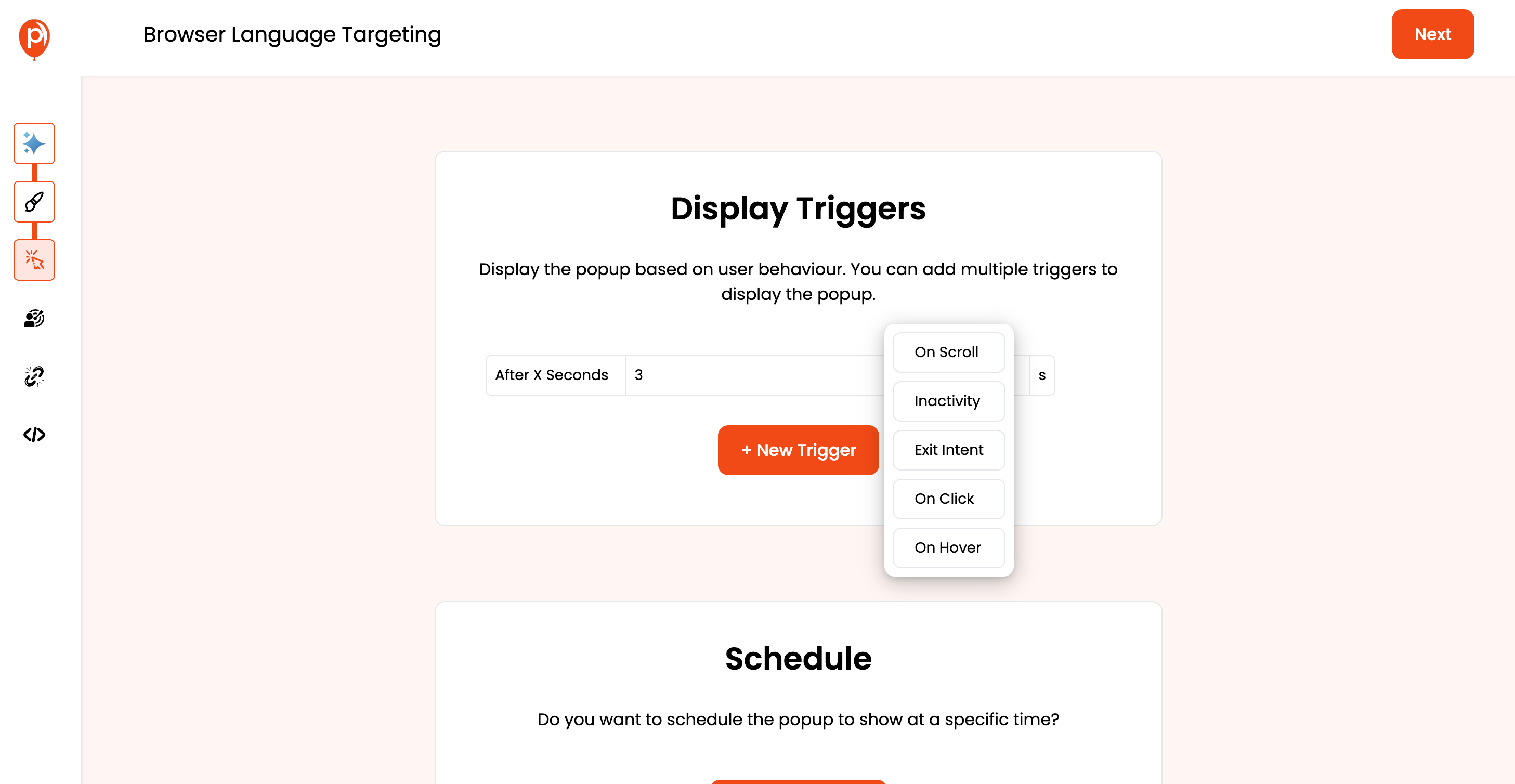
Choose the right triggers for your popup. Poper allows you to set up various triggers such as time delay, scroll depth, or exit intent. For language-specific popups, you might want to consider triggers that reflect the engagement level or specific actions of users within different language groups.
Step 5: Implement Language Filtering

To target users based on their browser language, enable the language filtering option. Here, you can select from a list of languages you wish to target, such as English, Spanish, French, etc. Poper will display the popup to visitors whose browser settings match the selected languages.
Step 6: Save and Publish
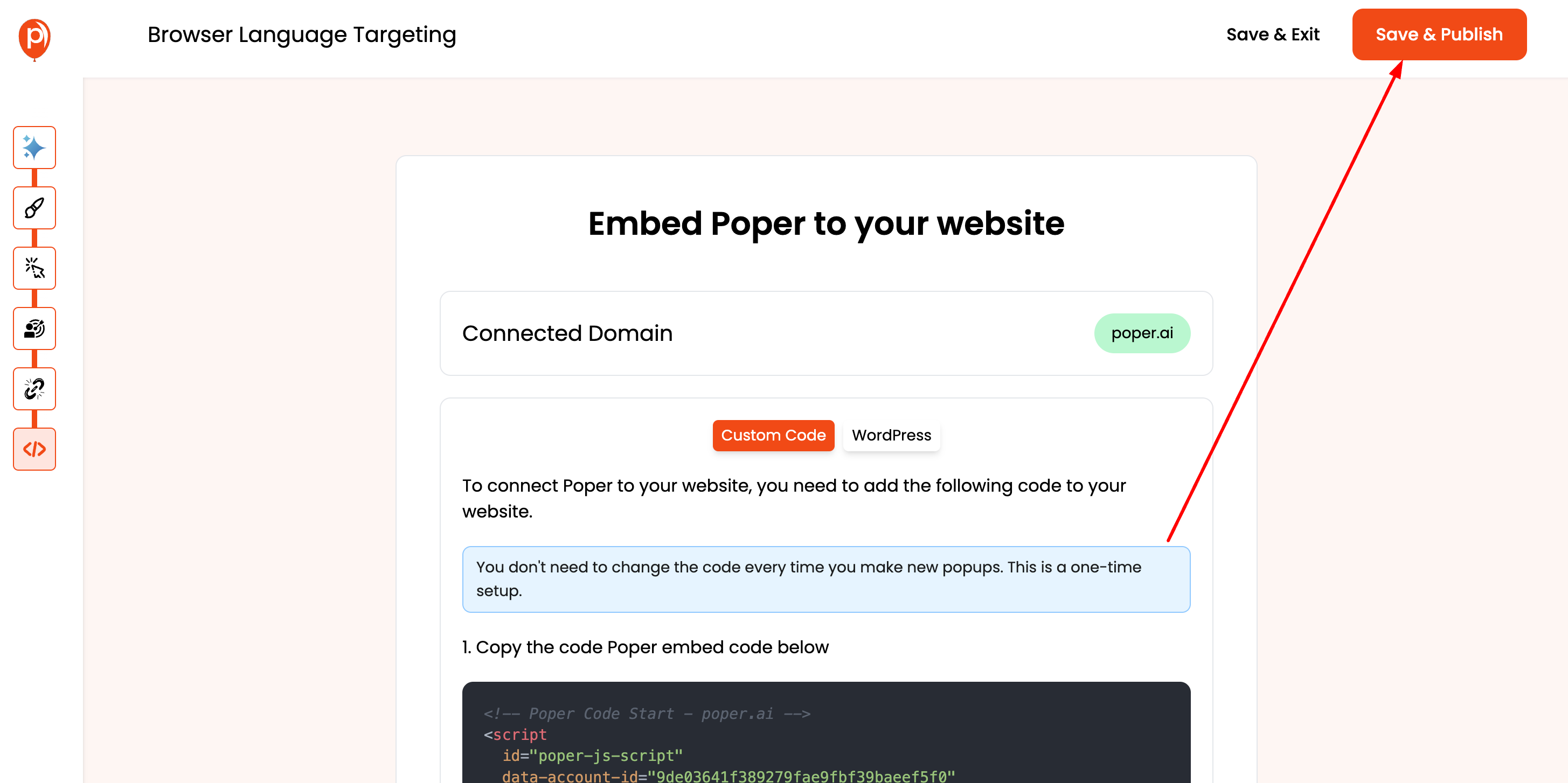
Once your popup is ready, with all languages and triggers set, save your changes. You can then publish the popup, making it live on your site. Poper provides a simple embedding process, where you only need to add a single line of code to your website, making the integration seamless.
Designing Effective Language-Specific Popups
Creating popups that are not only linguistically accurate but also visually appealing and engaging is crucial for success in different linguistic markets. Here’s how to design effective language-specific popups:
Essential Components of a Gamified Popup
Visual Consistency: Ensure that your popups maintain visual consistency with your brand to reinforce brand identity across different languages. This includes using your brand colors, logos, and style guidelines.
Adaptability: Design your popups to be adaptable. Text length can vary significantly between languages, so ensure your design can accommodate these changes without losing aesthetic or functional quality.
Design Tips to Enhance User Interaction
Cultural Relevance: Incorporate culturally relevant elements that resonate with each target audience. This might include images, colors, or motifs that are familiar and appealing to users from specific cultural backgrounds.
Simplicity and Clarity: Keep the design simple and the message clear. Overly complex designs or messages can confuse users, reducing the effectiveness of your popup.
Incorporating Brand Elements into Game Design
Brand Voice: Even when translated, the text in your popups should maintain the brand’s voice and tone. Consistency in how your brand communicates reinforces trust and recognition.
Interactive Elements: Depending on the complexity and purpose of the popup, consider adding interactive elements like sliders, hover effects, or animation that work seamlessly across languages.
Crafting Content for Multilingual Popups
Creating content for multilingual popups involves more than just translation; it requires a deep understanding of cultural nuances and preferences to craft messages that resonate across different languages and cultures.
Writing Engaging and Clear Game Instructions
Clarity: Ensure that the instructions in your popups are clear and easy to understand. Avoid jargon and complex language that might not translate well or could be misunderstood by non-native speakers.
Engagement: Use engaging language that invites interaction. Questions, direct calls to action, and interactive prompts can help maintain user interest and encourage participation.
Importance of Concise Messaging in Gamification
Brevity: Keep your messages short and to the point. Concise messaging helps prevent information overload and ensures that the main points are not lost in translation.
Impact: Every word should serve a purpose in your popup. Effective use of language can lead to higher engagement rates and better conversion outcomes.
Technical Aspects of Language-Specific Popups
Ensuring that your multilingual popups function flawlessly across various devices and browsers is critical. Here’s how to handle the technical setup:
Integrating Language Targeting with Poper Features
Advanced Settings: Utilize Poper's advanced settings to configure language-specific options. This includes setting different triggers and conditions based on the user's browser language.
Dynamic Content: Implement dynamic content changes within Poper that automatically adjust based on the detected language, ensuring a tailored user experience.
Ensuring Cross-Browser and Cross-Device Compatibility
Responsive Design: Make sure your popups are responsive, meaning they adapt seamlessly to any screen size and device type. This is crucial for maintaining functionality and appearance across platforms.
Browser Testing: Regularly test your popups on multiple browsers (such as Chrome, Firefox, Safari) to ensure consistent behavior and appearance. Address any discrepancies or issues to guarantee a smooth user experience.
Troubleshooting Common Technical Issues
Loading Speed: Monitor the impact of your popups on site loading times. If they significantly slow down your website, consider optimizing images and scripts within the popup.
Script Conflicts: Occasionally, popup scripts might conflict with other elements or scripts on your website. Work closely with your development team to resolve these issues promptly to prevent any negative impacts on user experience.
User Experience with Language Targeting
Optimizing user experience (UX) is crucial when implementing language-targeted popups. A positive user interaction not only enhances engagement but also contributes significantly to the success of your campaigns.
Optimizing User Experience with Language-Aware Popups
User-Centric Design: Design your popups with the user in mind. Ensure that the language switch is seamless and intuitive, allowing users to feel respected and understood no matter their language preference.
Relevance and Context: Make sure that the content delivered through your popups is relevant to the user’s context. This increases the likelihood of a positive response and reduces the chance of the popup being perceived as intrusive.
Best Practices for Language Selection and User Preferences
Easy Language Switching: Provide an easily accessible option for users to switch languages if the automatically detected language does not meet their preference. This enhances user autonomy and satisfaction.
Remembering User Preferences: Utilize cookies or local storage to remember user language preferences across sessions. This thoughtful touch can significantly enhance the user experience by providing personalized interactions on repeat visits.
Balancing Information Quantity and User Engagement
Concise Content: Keep popup content concise and to the point to maintain user interest and reduce cognitive load.
Engagement Techniques: Use interactive elements such as quizzes, polls, or sliders in your popups to keep users engaged and encourage interaction.
Testing and Optimizing Language-Specific Popups
To ensure that your multilingual popups are as effective as possible, it's crucial to employ a rigorous testing and optimization strategy. This process helps to refine your approach based on actual user interactions and feedback.
How to Conduct A/B Testing with Multilingual Popups
Setup A/B Tests: Implement A/B tests to compare different versions of your popups in various languages. This might involve testing different calls to action, designs, or messaging to see which performs best.
Segment Your Audience: Make sure to segment your audience based on language and perhaps other demographic data to ensure that the results are relevant and actionable.
Metrics to Measure the Effectiveness of Language Targeting
Conversion Rates: Track how often users take the desired action after seeing the popup.
Engagement Metrics: Measure engagement indicators such as time spent on page after seeing the popup or interaction rates with the popup content.
Bounce Rates: Monitor whether there is an increase in bounce rates for pages with language-specific popups, which could indicate a mismatch between the popup content and user expectations.
Continuous Improvement Cycle for Popups
Gather Feedback: Collect and analyze user feedback specifically regarding language use and preferences.
Iterate Based on Data: Use the insights gathered from A/B testing and user feedback to make informed adjustments to your popup strategies.
Monitor Performance Over Time: Keep an eye on the long-term performance of your popups and continue to optimize based on changing user behaviors and feedback.
Advanced Language Targeting Techniques
As technology evolves, so do the methods to enhance popup effectiveness through advanced language targeting techniques. These innovations can significantly improve personalization and user engagement.
Leveraging AI for Dynamic Language Personalization
AI-Driven Content Customization: Utilize artificial intelligence to dynamically alter popup content based on the user's past interactions, preferences, and behavior. This ensures that the language and message are always tailored to the individual’s context and needs.
Predictive Language Modeling: Implement machine learning models that predict the most effective language and messaging strategies based on user data, increasing the relevance and impact of your popups.
Implementing Real-Time Language Switching Mechanisms
Instant Language Adaptation: Develop popups that can instantly switch languages based on real-time detection of user preferences or changes in browser settings. This flexibility enhances user experience by providing immediate personalization.
Multi-Language Support: Ensure that your popups can support multiple languages simultaneously, allowing users to choose their preferred language effortlessly from within the popup itself.
Frequently Asked Questions About Increasing Popup Conversions
What is the average conversion rate for popups?
The average conversion rate for popups can vary widely depending on the industry and the specific design and content of the popup. However, a well-designed popup typically has a conversion rate of around 3-5%. High-performing popups, especially those with personalized content, can achieve rates of 9-11% or higher.
How often should I change the content of my popups?
It’s recommended to update your popup content regularly to keep it fresh and relevant. This could mean updating every few months or whenever you launch a new campaign or promotion. Frequent A/B testing can also help determine when changes are needed to optimize performance.
What are the most effective incentives for popup conversions?
Effective incentives vary by audience, but some common ones include discounts, free shipping, downloadable resources (like e-books or guides), and exclusive access to content or events. The key is to offer something that provides immediate value to the user.
How can I make my popups less intrusive yet effective?
To make popups less intrusive, use strategies such as exit-intent popups, which only appear when a user is about to leave the page, or time-delayed popups that show after a user has been on the site for a certain period. Ensuring the popup is easy to close and doesn’t obstruct the main content can also improve user experience.
How can I ensure accurate language detection for my popups?
Accurate language detection can be ensured by relying on the browser's language settings, which most users configure according to their preferences. Implement fallback options for common languages and offer an easy way for users to switch languages if the detected language is incorrect.
Conclusion
Browser language targeting is a powerful strategy that significantly enhances user experience and engagement. By delivering content in the user's preferred language, you can create a more personalized and relevant interaction, which in turn can lead to higher conversion rates and improved user satisfaction. This approach not only respects cultural differences but also leverages them to build stronger connections with your audience.


